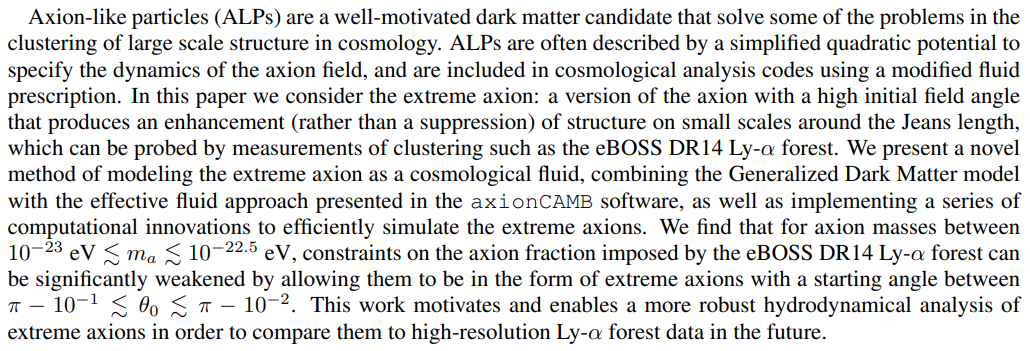Extreme Axions Unveiled: A Novel Fluid Approach for Cosmological Modeling - Abstract and Intro

:::info
This paper is available on arxiv under CC 4.0 license.
Authors:
(1) HARRISON WINCH, Department of Astronomy & Astrophysics, University of Toronto and Dunlap Institute for Astronomy and Astrophysics, University of Toronto;
(2) RENEE´ HLOZEK, Department of Astronomy & Astrophysics, University of Toronto and Dunlap Institute for Astronomy and Astrophysics, University of Toronto;
(3) DAVID J. E. MARSH, Theoretical Particle Physics and Cosmology, King’s College London;
(4) DANIEL GRIN, Haverford College;
(5) KEIR K. ROGERS, Dunlap Institute for Astronomy and Astrophysics, University of Toronto.
:::
Table of Links
Abstract and Intro
Methods
Phenomenology
Discussion and Future Work
Conclusion
Acknowledgments and References
ABSTRACT
1. INTRODUCTION
Axion-like particles (ALPs) are a broad class of dark matter (DM) particle candidates that possess both a strong theoretical justification and a variety of potentially observable signatures. While the traditional quantum chromodynamics (QCD) axion is a pseudo-Nambu-Goldstone boson arising from a broken Peccei-Quinn symmetry (Peccei & Quinn 1977), ALPs can arise from broken symmetries more generally, and are produced naturally from a variety of string theories as a result of compactified higher dimensions, making them a well-motivated DM particle candidate (Dine & Fischler 1983; Preskill et al. 1983; Abbott & Sikivie 1983; Svrcek & Witten 2006; Duffy & van Bibber 2009; Arvanitaki et al. 2010; Marsh 2016; Adams et al. 2022). Throughout this work, we will use axion and ALP interchangeably to refer to this broad class of low-mass pseudo-Nambu-Goldstone boson DM candidates.
\
\
\
\
\
Some work has been done to model the evolution of the axion field with these extreme starting angles, such as the works of Cedeno et al. ˜ (2017); Zhang & Chiueh (2017b); Leong et al. (2019); Zhang & Chiueh (2017a). However, the rapidly-oscillating nature of these axion fields (both at the background and perturbation level) necessitates extremely high temporal resolution for the computations, requiring long computation times for a brute force solution Zhang & Chiueh (2017b,a). This makes running repeated estimates of the axion evolution, of the sort required for a Markov Chain Monte Carlo (MCMC) or other likelihood sampler method, prohibitively expensive.
\
In this work, we present a novel method of efficiently and accurately modeling the behaviour of these extreme axions as a cosmological fluid. We follow the structure of the vanilla axion modeling code axionCAMB, explained in more detail in Hlozek et al. ˇ (2015). We implement a number of innovations and improvements to axionCAMB compute predictions for cosmological observables such as the linear MPS. These innovations, described in more detail in the Section 2, include a restructuring of the initial conditions, and a novel effective sound speed of the extreme axion fluid. All of these innovations reduce the runtime to model extreme axions down to ∼ 7 seconds. This opens up new opportunities to put observational constraints on extreme axion models with higher-dimensional MCMC algorithms that require tens of thousands of calls to the axion evolution code.
\
\
\
Welcome to Billionaire Club Co LLC, your gateway to a brand-new social media experience! Sign up today and dive into over 10,000 fresh daily articles and videos curated just for your enjoyment. Enjoy the ad free experience, unlimited content interactions, and get that coveted blue check verification—all for just $1 a month!
Account Frozen
Your account is frozen. You can still view content but cannot interact with it.
Please go to your settings to update your account status.
Open Profile Settings